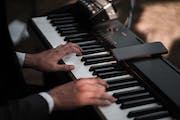Bruce Hornsby The Way It Is Piano Licks
 Would you like to learn how a Bruce Hornsby The Way It Is piano solo is made?
Would you like to learn how a Bruce Hornsby The Way It Is piano solo is made?
You’re in the right place.
Incorporating some of Bruce Hornsby The Way It Is piano licks will spice up your playing.
Let’s get started.
Bruce Hornsby The Way It Is Piano Solo Example
Before you explore some Bruce Hornsby licks, check out some of his playing right here.
Here’s a Bruce Hornsby The Way It Is Piano Improv from Woodstock ’99:
Now that you’ve heard Bruce Hornsby play some awesome lines, it’s time to learn some for yourself.
How To Use Blues Lines Like Bruce Hornsby
Here’s one of the nice blues piano licks from a call and response section in The Way It Is:
To begin learning the lick, follow these steps:
- First, listen to how Bruce plays it many times over.
- Second, slow down Bruce’s performance in the video, and pick out the notes by ear.
- If you need more help, here’s a lesson on how to play piano by ear.
- You can also use the transcription below to help you learn the lick:

If you look at the above lick, you’ll notice that this is based on a G major or E minor blues scale.
Since we talked about the blues, let’s talk about how to do it like Bruce Hornsby.
How To Play A Blue Note The Legitimate Bluesy Way
 A E minor blues scale is simply an E minor pentatonic scale with a b5.
A E minor blues scale is simply an E minor pentatonic scale with a b5.
In many cases, we don’t linger on the b5. It’s mostly treated like a decorative note.
To do this effectively like Bruce Hornsby, you have to learn a finger slide technique.
Any pianist with blues and jazz training will use fingers 2, 3, and 4 over a black key and slide it down or up to the white key beside it.
Let’s check out the first few grace notes:

Bruce plays the grace notes (A and Bb) with fingers 1 and 2. To land on B natural, you can simply let finger 2 slide down from Bb.
Look at the next instance of Bb:

In this case, Bruce would use finger 3 on Bb and then slide it down to the A beside it.
Now that you’ve learned a short Bruce Hornsby lick, let’s look at a longer phrase next.
How A Bruce Hornsby The Way It Is Piano Solo Gets Texture
Because playing an exciting solo is important, Bruce weaves in calculated variations in his solos.
Let’s look the next example here:
Interestingly, we see 4 different ideas going on in this passage. Here’s the transcription below:


The best way to approach learning this lick is by studying it one bar at a time.
In the first bar, you will see a nice phrase leading to a 16th note run that extends to the next bar.
When you go to the second bar, the 16th note run continues and ends on a repeated note theme.
This repeated note theme consists of repeated chord tones of a G major triad, each preceded by a note a half step below.
On the last bar, you find a nice blues tag.
Now that you have learned two licks from Bruce Hornsby, how do you progress from there?
How To Make Bruce Hornsby’s Licks Your Own
 Now that you have explored some awesome ideas from Bruce Hornsby, what’s next?
Now that you have explored some awesome ideas from Bruce Hornsby, what’s next?
It’s time to make them your own.
Now that you are able to play Bruce’s licks, follow these next few steps:
- First, apply the lick over any chord progression in the key of G.
- Next, use the lick in your own improvised solos.
- After mastering the lick in the key of G, transpose the lick to other keys.
- Lastly, use the lick in various songs when appropriate.
I hope you have enjoyed this lesson about Bruce Hornsby The Way It Is piano licks.
If you have any questions, comments, or suggestions for a new lesson, feel free to leave a comment below.
Now, get started working that out on your piano. Happy practicing.
